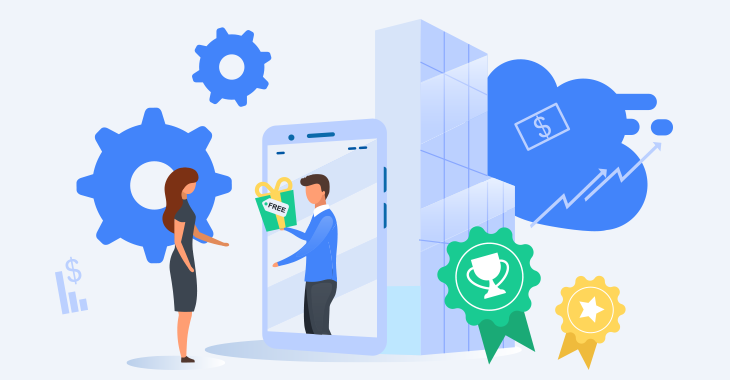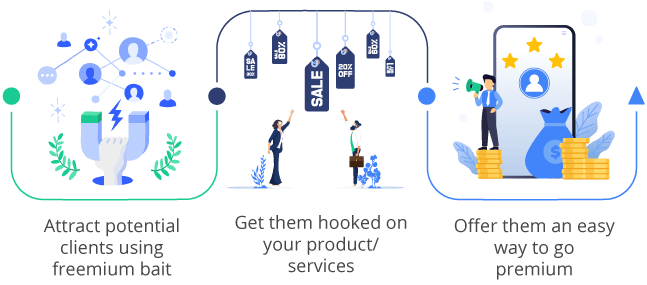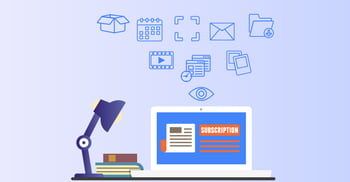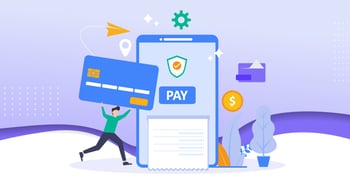Is Freemium Killing Your SaaS Business?

As with most industries, trends come and go within the SaaS space. The best option for your company today might be the worst one tomorrow.
That’s why it’s essential to understand different SaaS models before deciding which one is for you. This couldn’t be truer for the SaaS freemium model.
The SaaS freemium model is entering free users into a boat race. The freemium software is the boat, and the river is your customer’s journey. You want the potential customer to get in the boat and stay there until they cross the finish line - converting from SaaS free trial users to loyal, paying customers.
To get more free users to win this race, you must first understand exactly what the SaaS freemium model entails. But how did it come about? Why was the term ‘freemium’ coined?
Free + Premium: How Did That Happen?
Put simply: freemium = free + premium. Using the SaaS freemium model for your company means giving away a portion of the value you’ve created to gain user interaction. However, the ultimate goal is to establish a strong SaaS revenue infrastructure. The hope is that by using your product or service for free, users will recognize its value and be enticed into becoming paying customers who switch to the premium option.
Some companies use the SaaS freemium model to offer their full services for free, while others opt for keeping their best features only for premium users. Whatever the route, the formula is the same:

A Freemium Model is Just a Marketing Strategy
The debate around the SaaS freemium model is ongoing - is freemium a revenue model or a marketing strategy? Does it drive customer growth or bring in freeloaders? Freemium brings in new users, but it doesn’t mean instant revenue. The SaaS freemium model can be quite difficult to monetize successfully. This is one of the reasons why many view it as a marketing expense rather than a revenue stream.
It’s no secret that converting a free user into a paying customer using the SaaS freemium model takes work. It requires intimate knowledge of customers' mindset- motivations, habits, and goals. You’ll need to research different demographics and understand their unique customer journey. Truthfully, the processes that go into marketing strategies and using freemium models aren’t all different.
You might be thinking, ‘so what?’. Successful marketing is just as important as revenue - why not just use freemium for that?’ Well, it’s not that simple. When freemium goes wrong, it goes wrong and can lead to potential disaster for your business.
No 3rd party integrations. No hidden costs. No wasted time.
Just a solution as unique as your business’s needs.
Impact Analysis of Freemium Plans
While freemium might appear to be a surefire way to increase your client base, it’s not without its flaws. Let’s have a look at the SaaS freemium model in practice.
Here are six major cons to the SaaS freemium model:
Customer Retention Killer
Psychologically speaking, people often associate cost with value. The more something costs, the better it should be. By giving users free access to your services, you create the connection in their minds that if it is free, it’s not worth paying for. When using the SaaS freemium model, be aware that your free customers are not financially invested in your services and might not recognize its value. Achieving a high SaaS retention rate is hugely relevant for your business.
Customer Satisfaction Killer
Free users who have gotten used to a platform won’t want to relearn everything once they move to premium. They'll likely become frustrated if you force new customers to transition to a completely new platform with unfamiliar features and processes. The SaaS freemium model could be disastrous for your customer satisfaction levels.
Revenue Killer
A huge drawback to the SaaS freemium model is that free users don’t generate revenue. Unless your paid subscribers bring in enough money to support the cost of acquiring and serving all your users, you’ll be operating at a loss. You can’t turn a profit if you’re losing more than you’re making. Furthermore, when potential customers see that your services are offered as ‘free’, they might doubt the quality, putting them off purchasing upfront. When you sell SaaS online, creating strong revenue streams is essential.
Resource Killer
You know, in cartoons, when the donut truck overturns, and seemingly civilized people become warmongers over sugary desserts? They take way more than they need. Free users of your services will be no different. A major problem with the SaaS freemium model is that freemium users devour your resources because there’s often a limit on how much they can get. Ultimately you’ll be left with less time and money to invest in other areas of your company.
Performance Killer
It’s not just resources that the SaaS freemium model can have a detrimental effect on, but the performance of your services too. The more users you have, the more strain you put on your platform. A mass influx of new accounts can be too much for platforms to handle, resulting in technical problems and server issues, as well as legal ones in case SaaS compliance standards are not met. Not only will your services be functioning at a sub-par level, but loyal paying customers won’t be happy.
Reputation Killer
When free users use your services, their opinions and reviews will be based on what they’ve experienced. If the freemium version doesn’t include your best features, the reviews will be based on the lowest-quality version of your services. This won’t be a true reflection of what you offer and will give you a less-than-stellar reputation, ruining your chances with future customers. The SaaS freemium model can potentially damage your business’s brand and reputation.
Caveat: Freemium Can Work, But Only In Highly Specific Scenarios
So, we’ve clarified that the SaaS freemium model has weak points that could damage your business. But are these problems impossible to mitigate? Are there circumstances where the SaaS freemium model could work? The answer is a very cautious ‘yes’ with the disclaimer ‘in particular scenarios.
For some companies, the SaaS freemium model is viable and effective. If you’re at the point where your application is already making substantial revenue from paying users, then freemium could be a great fit to help drive more potential customers your way. After all, freemium isn’t all bad, and the model can effectively persuade people to try out your product or service.
The SaaS freemium model offers:
Free Attraction: removing cost makes it more attractive to use
Elimination of usage barriers: offering easy sign-ups and forgoing paperwork and credit card details makes your products easier to access
Easy sharing: free use makes it easier for users to share your products with their networks and convince others to try it
With careful planning, the problems associated with the SaaS freemium model can be overcome, but this still doesn’t mean it’s for you. So, how do you know whether to take the freemium plunge or steer clear of its allure?
Ask Yourself Some Questions Before Considering a Freemium Model
The SaaS freemium model can be an excellent business and marketing tool. But first, there are some important questions you need to ask yourself, starting with, “Is freemium the right fit for your SaaS company?”
Of course, there are other points to consider:
Why are you offering the product for free?
First, you must look at your motivations and intentions for using the SaaS freemium model. Why do you want to offer anything for free? What do you expect in return? Do you need to provide this product for free?

As mentioned, freemium becomes a problem when the number of free users outgrows the amount of support generated by paid users – trust us, it doesn’t end well. Before choosing freemium, make sure you research and test different revenue models to see what’s out there and what
would fit your company best.
For example - If you’re offering free use because you want to expand your brand presence and aren’t concerned with revenue increase, then freemium is a great option. But if you’re intending for freemium to bring in paying customers and keep your business financially viable, you might want to re-think your ‘why’.
How will you benefit by offering a freemium model?
Next, you’ll need to figure out how the SaaS freemium model will benefit your business. Will the model bring you customers from your target audience, or will it attract people with little to no interest in your products?
Non-target users are unlikely to convert to paying customers and so won’t bring in revenue. Before switching to the SaaS freemium model, do your homework and figure out whether you will benefit by using freemium.
What will motivate users to upgrade from your freemium model to the paid version?
Answering this question means delving deep into the mindset of your users and figuring out precisely what will make free users convert to paying customers. You’ll need to:
Conduct thorough market research on your potential customer - what they are looking for and why they would choose your product. Knowing your metric value is imperative to understand whether or not the SaaS freemium model will work for your business.
Make sure the size of your market for freemium software is sustainable long-term. Small market size is one of the reasons that freemium doesn’t work for niche services. For the SaaS freemium model to work, it needs a mass audience.
Before using the SaaS freemium model, you must have your customer journey mapped out to guide your users from free to paid. Without this path, they may not feel they need to upgrade. Test different pricing and positioning models to determine precisely what will trigger your free users to reach for their credit cards.
Is there a way to monetize users even if they don’t convert?
Another useful question is whether you can monetize free users, even if they never go premium. Can you monetize non-conversions? Can non-conversations save you money?

While non-conversions don’t bring you direct revenue, there are some ways you can monetize users even if they don’t convert. Integrating a strong referral program into your offerings is a great way to do this. This could lead to viral growth for your SaaS product and increase your revenue in the long run.
Users who don’t convert can also be used to save money on other business costs. The SaaS freemium model has low customer acquisition costs (CAC) by using word-of-mouth marketing to amplify your business’s presence. Free users can spread awareness of your services and help market them for free. So even if a free user doesn’t convert, they’ll refer someone who will. This saves you money on marketing expenses like sales teams or ad campaigns.
Can you collect actionable market intelligence from both free and paid users?
Be mindful that while the SaaS freemium model can give you actionable market intelligence, this only works if free users are in or around your target market. If free users aren’t interested in your services, then the information you get from them won’t be a true reflection of what your greater target market is looking for.
Nevertheless, using the SaaS freemium model can help you collect valuable data. Using freemium, you can -
You can gather information about users when they sign up or download your products. Use this to determine who the free users are and pick up on any patterns and trends between them. You can then prioritize your sales efforts and expand your target market.
You can look at the usage from current customers (free and paid) to figure out what features of your software are popular and which are ignored. This could give you relevant insights about other pricing models worth using, like the famous usage-based billing. You could also gather feedback directly from users and use this to improve the functionality of your products.
Mass usage on a freemium platform is ideal for A/B testing. Your teams can analyze the data and understand market segmentation and funnel efficiency. This can be used to improve the onboarding experience for new users.
No 3rd party integrations. No hidden costs. No wasted time.
Just a solution as unique as your business’s needs.
Freemium Distribution and Customer Acquisition
If you answered positively to the questions above and are planning on taking the freemium plunge, here are some key takeaways about freemium distribution and customer acquisition:
![]() Secure your infrastructure: The SaaS freemium model needs viral adoption to work. So, if this is your goal, you’ll need to ensure that your platform’s infrastructure is suited to hold a mass audience. .
Secure your infrastructure: The SaaS freemium model needs viral adoption to work. So, if this is your goal, you’ll need to ensure that your platform’s infrastructure is suited to hold a mass audience. .
![]() Keep costs low: If your freemium subscription is going to work, you must create low marginal costs to support the number of free users on your platform.
Keep costs low: If your freemium subscription is going to work, you must create low marginal costs to support the number of free users on your platform.
![]() Run the numbers: Freemium plans are not a guaranteed formula for success. Before choosing the SaaS freemium model, you must ensure your retention and upsell rates match the CAC benefits.
Run the numbers: Freemium plans are not a guaranteed formula for success. Before choosing the SaaS freemium model, you must ensure your retention and upsell rates match the CAC benefits.
![]() Know your customer: If the SaaS freemium model is going to work for your business, you’ll need to know your customers like your services before you offer anything for free. Otherwise, you’re gambling with your business's future.
Know your customer: If the SaaS freemium model is going to work for your business, you’ll need to know your customers like your services before you offer anything for free. Otherwise, you’re gambling with your business's future.
![]() Keep it simple: Generally, freemium users aren’t looking to study the ins and outs of your product. You’ll need to get their attention to convince them to convert. Keep your services directly, and try to solve any customer problems that may arise as soon as possible.
Keep it simple: Generally, freemium users aren’t looking to study the ins and outs of your product. You’ll need to get their attention to convince them to convert. Keep your services directly, and try to solve any customer problems that may arise as soon as possible.
The Bottom Line: Use Freemium with Caution, If At All
If you decide that the SaaS freemium model is for you, that’s great – it’s a model that can be a strategic weapon for the right company in the right circumstances. Regardless of your decision, freemium should be approached with extreme caution as the variables for its success are hard for most businesses to cultivate. To find out more about how to successfully sell software online and SaaS products and services, achieve global SaaS compliance, and locate a partner that can handle international taxation, message PayPro Global today – we can help you plan for success.
Hanna Barabakh
Hanna Barabakh is a language and content specialist passionate about SaaS, technology, and e-commerce. Her expertise in multilingual content, connected to her background in Lexicography and Translation Studies, allows her to communicate complex ideas across cultures easily. She uses her knowledge to create engaging content that resonates with global audiences. In her spare time, she enjoys reading and exploring new ideas.
-
1.Explore PayPro Global's Solutions: See how our platform can help you streamline your payment processing and boost revenue.
-
2.Get a Free Consultation: Discuss your specific needs with our experts and discover how we can tailor a solution for you.
-
3.Download our Free Resources: Access valuable guides, checklists, and templates to optimize your online sales.
-
4.Become a Partner: Expand your business by offering PayPro Global's solutions to your clients.
Get the latest news



